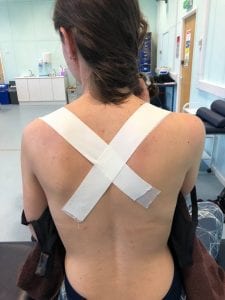In this 2-hour session, as part of open clinic, I performed treatment on two different clients. We did not have very many appointments scheduled, so I paired up with another therapist where we treated together. For the first client the other therapist took the lead by completing the clinical consultation form and deciding an appropriate treatment. For the second client it was my turn to do this.
| Reflective Summary
For the first hour of open clinic the client complained of achiness in their lower back. The other sports therapist and I observed their posture and noticed the right shoulder was higher than the left. When I palpated the inferior angle of the scapula the right one was a lot higher. The same thing was evident with the Posterior Superior Iliac Spine (PSIS) on the right side. After testing ROM, we decided we would use soft tissue massage and stretching to try and release some of the tension in the lower back. The client wanted to be kept modest so we effectively used the screens and towelling techniques to ensure there was as much privacy as possible when they were removing there top. Once we began the massage we started off with effleurage to create some heat which could be seen as there was erythema (redness on the skin). It is also important to use this technique before going deeper as it can be an early warning sign for potential injuries and you can also gauge where the hypersensitiveness is. I communicated well with the client to ensure the pressure was enough and they explained there was more tightness on the left side which I also noticed from using effleurage. I then introduced petrissage and used my knuckles and elbow to try and release the knots and areas of tension. Once I had finished soft tissue massage I asked the client to put their clothes back on so I could demonstrate some stretches that they could use which will help with increasing flexibility. I also observed them performing the stretches to ensure they were using the right technique.
For the second hour I had a client who had supraspinatus impingement around their left shoulder. During the objective assessment I observed that they had poor posture as their shoulders were in retraction. When I palpated underneath the medial border of the scapula I felt a lot of tightness and knots. From this I decided that I would do soft tissue massage to release some of the tension and use taping to correct their posture. In the subjective section of the consultation form I checked for any contraindications and found out that they were allergic to K tape. I started the massage on the trapezius, supraspinatus and infraspinatus by using effleurage to increase the blood flow. I then used petrissage (mainly kneading) to release some of the tightness in and around the scapula. I used my knuckles and thumbs to get deeper and to continue to increase blood circulation. I then finished off the treatment and prepared to do taping. As they were allergic to K tape, at the start of the session I put underlay tape on the clients arm to see if this had any affect. When I wanted to put the taping on I checked to see if there was a rash on the arm and there was not. This meant that I could use the underlay and perform the mid thoracic/rhomboid taping method. I then placed rigid taping over the underlay to try and correct her posture. Areas for further improvement My first area for improvement is to ensure I begin to use clinical abbreviations when filling out the client consultation forms. This will be beneficial as it will give me more space to write the notes in the boxes and it can also be done quicker, so there is more time for hands on treatment. I also need to make sure that I always test range of movement (ROM) before beginning the treatment as it will allow me to see if the session and techniques chosen have been effective. To ensure I do this I may need to look at how you test ROM for different joints and areas of the body. My final improvement would be to begin to research common injuries so I can understand the pathology and how it can be best treated. Things to remember

|
